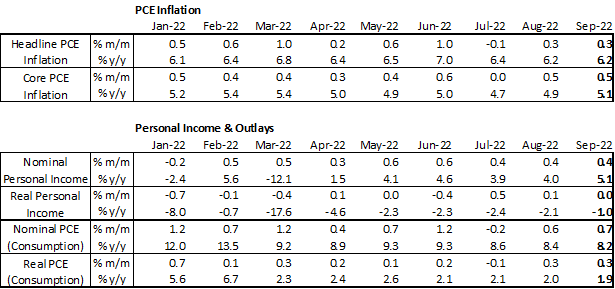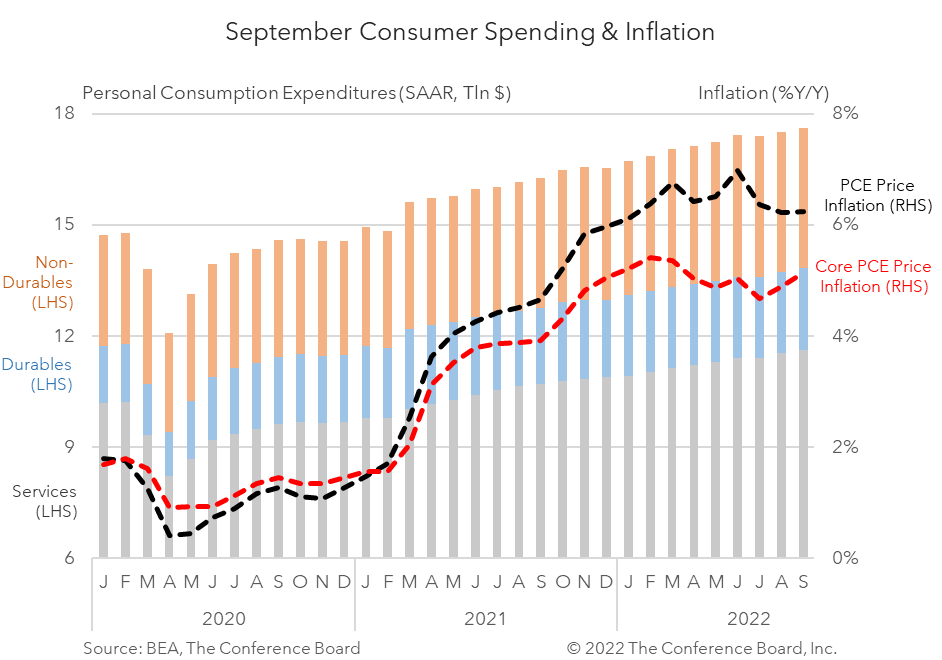Inflation continued to weigh on incomes and spending
28 Oct. 2022 | Comments (0)
September Personal Income & Outlays data show an economy that continues to grapple with inflation. Month-over-month (m/m) readings for both headline and core PCE inflation were unchanged from August, but year-over-year (y/y) core inflation rose to 5.1 percent (the highest reading since March). These inflation metrics remain far too high. Indeed, according to the BEA the 0.4 percent m/m increase in personal income in September was wiped out when accounting for inflation. Furthermore, increases in consumer spending in September were also partially offset by rising prices. These data will likely encourage the Fed to make another large 75 basis point increase in the Fed Funds rate next week. Looking ahead, the stagflationary characteristics of the US economy are likely to give way to a recession beginning in Q4 and extending into early 2023.

Headline PCE price inflation was flat at 6.2 percent y/y in September, but core PCE price inflation rose to 5.1 percent y/y. However, on a month-over-month basis both inflation metrics remained about the same, with core inflation actually falling slightly to 0.45 m/m percent from 0.54 m/m percent in August. These data show neither a meaningful improvement nor a deterioration in the inflation situation, but it remains quite clear that the readings remain far too high. When the FOMC meets next week we’ll likely see another 75 basis point interest rate hike.
Overall personal income growth rose 0.4 percent m/m (in nominal terms), vs. 0.4 m/m percent in August. However, the increase was more than offset by rising prices. In inflation-adjusted terms, personal income was flat from August. Indeed, eight of the last twelve months have seen either flat or negative real income growth. Thus, while Americans have recently seen their incomes rise in nominal terms, their purchasing power eroded just as quickly.
Personal consumption expenditures rose by 0.7 percent m/m (in nominal terms) in September, vs. 0.6 m/m percent in August. Spending on services rose by 0.8 percent m/m while spending on goods rose 0.3 percent m/m. However, after accounting for inflation, consumer spending rose by just 0.3 percent m/m in September with spending on goods rising 0.4 percent m/m and spending of services rising 0.3 percent m/m. We expect personal consumption expenditures to slow further over the coming months as tighter monetary policy drives interest rates higher.
Personal income and consumer spending will face continued challenges in the months ahead. Headline inflation may have peaked in Q2 2022, but persistence of elevated inflation rates in the face of rising interest rates is troubling. These developments are likely to weigh on consumer spending and should prompt the Federal Reserve to continue hiking interest rates in large increments over the coming months. This environment increases the probability and potential severity of a recession.

-
About the Author:Erik Lundh
Erik Lundh is Senior Global Economist for The Conference Board Economy, Strategy & Finance Center, where he focuses on monitoring global economic developments and overseeing the organization&rsquo…




0 Comment Comment Policy